The content of this webpage is intended to provide formulators and manufacturers an awareness of the peer-reviewed, scientific data available on pure Australian Tea Tree Oil and its reported anti-viral and virucidal properties.
These data do not suggest that any formulation containing pure Australian Tea Tree Oil will act in an anti-viral or virucidal manner.
These data do not eliminate a manufacturer’s responsibility to conduct proper trials for safety and efficacy.
For many year, scientists have published results demonstrating the efficacy of Tea Tree Oil against a wide range of microbials. From bacteria to fungi, yeasts, and viruses. To date, over 850 peer, reviewed scientific papers have been published specifically on the functional properties and efficacy of pure Australian Tea Tree Oil.
Tea Tree Oil is a natural and complex mixture of terpenes and sesquiterpene alcohols, produced through steam distillation of the harvested biomass of the Australian native tree Melaleuca alternifolia. It is defined by the ISO standard 4730: 2017 to assure purity and consistency.
In Part I: Tea Tree Oil as an Anti-Viral, we documented the relevant published scientific data. In Part II: How a Virus Infects a Host Cell, we explored the mechanism by which a virus attaches and transmits genetic material to a host cell.
On this page, we detail the scientific, peer-reviewed and published details for the mechanism of how pure Australian Tea Tree Oil can inactivate a virus, preventing it from infecting a host cell.
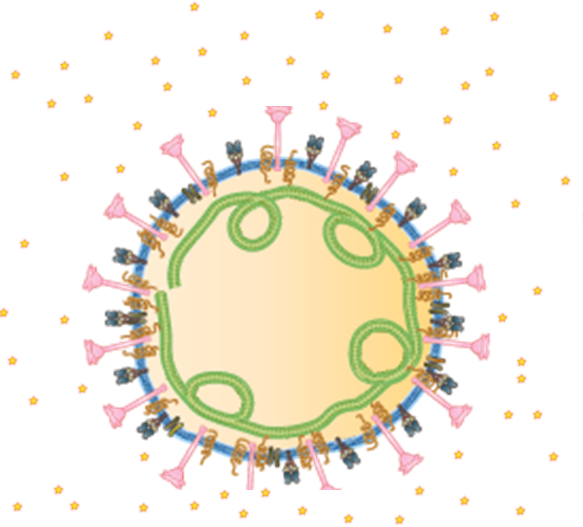
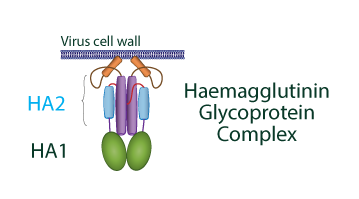
As discussed in Part II: How a Virus Infects a Host Cell, viruses have an intricate combination of proteins and other structures embedded in their outer wall. One of these is called the Haemagglutinin Glycoprotein Complex (HA Complex).
The HA Complex consists of several proteins which work in concert to effect host cell wall binding and transfer of viral genetic material to this new host. While there are many intricate components within this complex, most important are the HA1 and HA2 proteins.
When pure Australian Tea Tree Oil comes in close proximity with a virus, its anti-viral mode of action disrupts the proper functioning of the virus' Haemagglutinin glycoprotein (HA) complex.
In contrast to a properly functioning HA Complex, Tea Tree Oil interferes with the unfolding of the HA2 protein.
Without this preparatory 'unfolding' step, the HA complex is not able to attach to the host cell wall and position itself for viral transfer of genetic material.
This anti-viral mode of action involving Pure Australian Tea Tree Oil has been reported by two separate research teams (Li and Garozzo), acts upon the HA Complex.
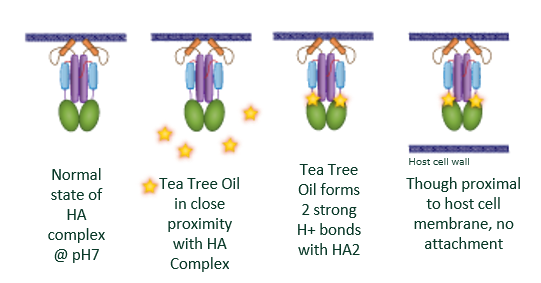
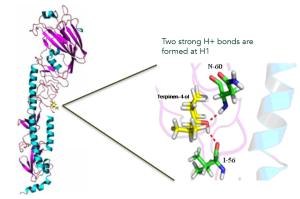
The evidence for this unique binding capacity between Tea Tree Oil's components and HA proteins was developed by research teams from Sun Yat-sen University (Guangzhou, Guandong, China) and Griffith University (Queensland, Australia).
Li Xinghua, Duan Songwei, Chu Cordia, et al. reported in the journal Molecules in 2013, on the results of their in vitro studies on the ability of Tea Tree Oil to inhibit Influenza virus from entering host cells. In confirming this inhibition ability, the authors went on to analyse the molecular structure of the influenza virus as well as key components of Tea Tree Oil, namely Terpinen-4-ol.
In a further in silico analysis using molecular dynamics, the authors confirmed the Hydrogen binding at two locations on HA-2 protein. The resultant shape of HA-2 following exposure to Tea Tree Oil correlated to what was predicted in the in silico model.
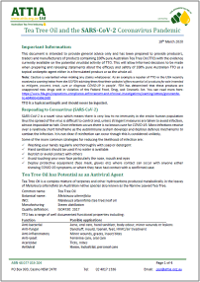
In conjunction with the Australian Tea Tree Industry Association (ATTIA), we have prepared this information in a downloadable (pdf) format. Input your email address and we will send this straight to your Inbox.
If you have any questions, please talk with your local Down Under Sales Representative, Commercial Partner for your country, or EMAIL us.
Astani A, Reichling J, Schnitzler P (2010) Comparative Study on the Antiviral Activity of Selected Monoterpenes Derived from Essential Oils. Phytotherapy Research. 24:673-679.
Böhme K., Barros-Velázquez J., Calo-Mata P., Aubourg S.P. (2014) Antibacterial, Antiviral and Antifungal Activity of Essential Oils: Mechanisms and Applications. In: Villa T., Veiga-Crespo P. (eds) Antimicrobial Compounds. Springer, Berlin, Heidelberg.
Brun, P., Bernabè, G., Filippini, R. et al. (2019) In Vitro Antimicrobial Activities of Commercially Available Tea Tree (Melaleuca alternifolia) Essential Oils. Current Microbiology 76:108–116.
Capetti F, Sgorbini B, Cagliero C, et al. (2020) Melaleuca alternifolia Essential Oil: Evaluation of Skin Permeation and Distribution from Topical Formulations with a Solvent-Free Analytical Method. Planta Med. 1-9.
Garozzo A, Timpanaro R, Bisignano B, et al., (2009) In vitro antiviral activity of Melaleuca alternifolia essential oil. Letters in Applied Microbiology, 49:806-8.
Garozzo A, Timpanaro R, Stivala A, et al., (2011) Activity of Melaleuca alternifolia (tea tree) oil on Influenza virus A/PR/8: study on the mechanism of action. Antiviral Research, 89(1):83-8.
Li X, Duan S, Chu C, Xu J et al., (2013) Melaleuca alternifolia Concentrate Inhibits in Vitro Entry of Influenza Virus into Host Cells. Molecules, 18, 9550-66.
Pyankov OV , Usachev EV, Pyankova O, Agranovski IE, (2012) Inactivation of Airborne Influenza Virus by Tea Tree and Eucalyptus Oils, Aerosol Science and Technology, 46:12, 1295-1302.
Southwell I (2007) Tea Tree Stability and Evaporative Rate. RIRDC Industry Publications, Australian Federal Government.
van Vuuren SF, Suliman S, Viljoen AM (2009) The antimicrobial activity of four commercial essential oils in combination with conventional antimicrobials. Letters in Applied Microbiology. 48:440-46.
Head Office and Operations, 19A Boundary Street, Darlinghurst Sydney, NSW 2010
Buhlambar Farm, 497 Tomki-Tatham Rd, Tatham, NSW 2471